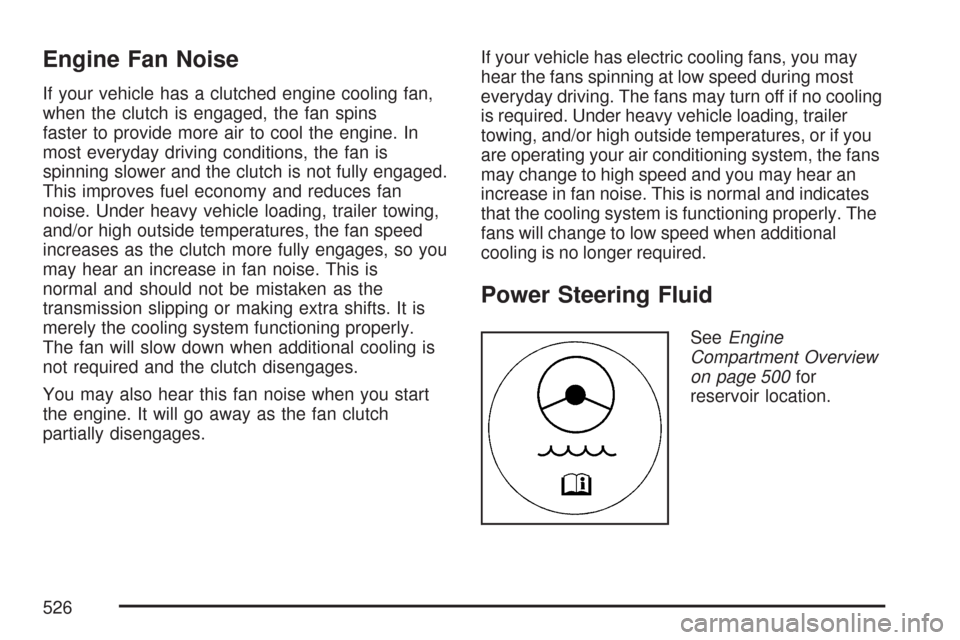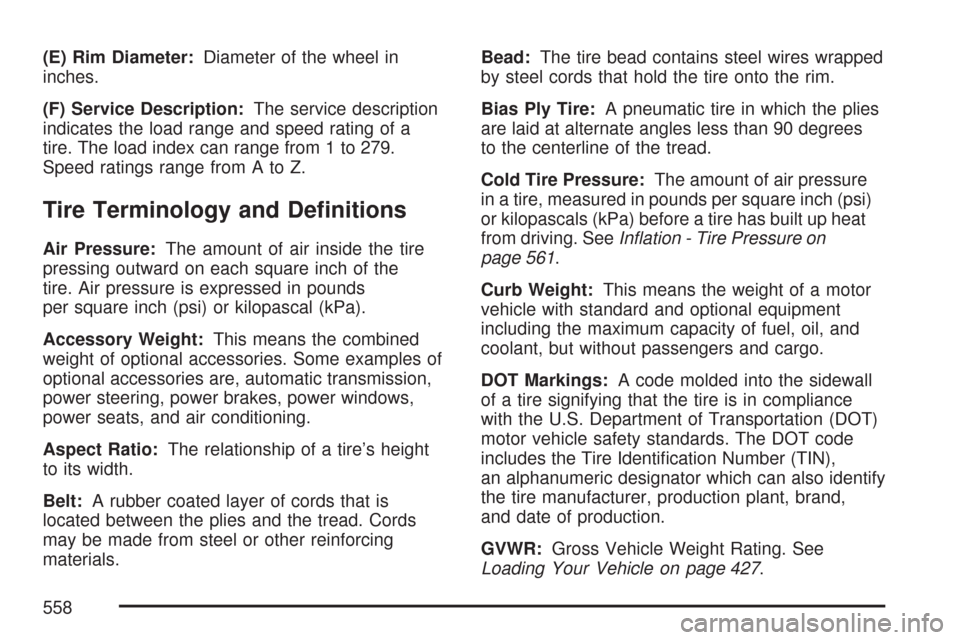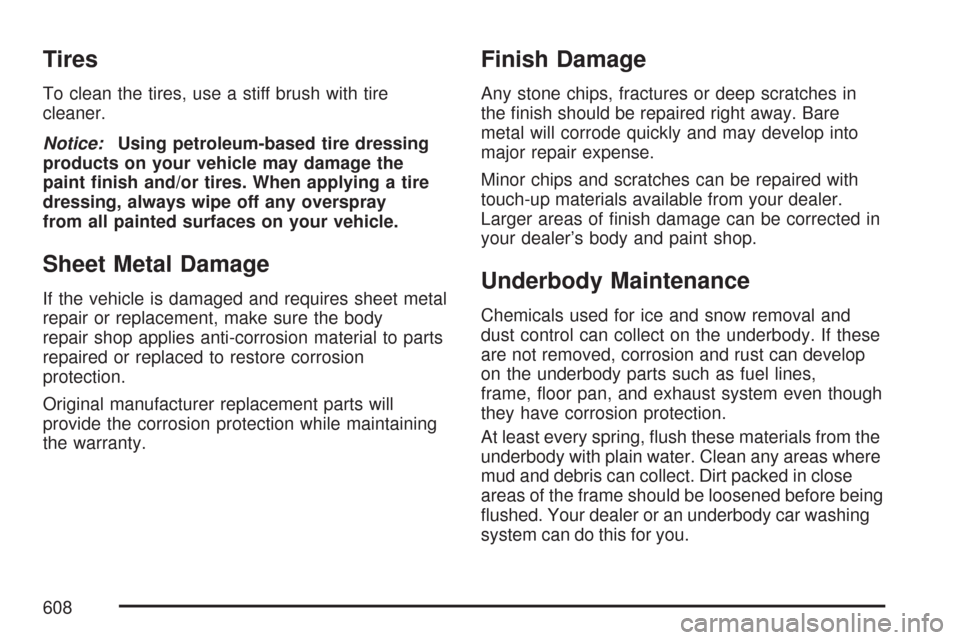Page 526 of 684

Engine Fan Noise
If your vehicle has a clutched engine cooling fan,
when the clutch is engaged, the fan spins
faster to provide more air to cool the engine. In
most everyday driving conditions, the fan is
spinning slower and the clutch is not fully engaged.
This improves fuel economy and reduces fan
noise. Under heavy vehicle loading, trailer towing,
and/or high outside temperatures, the fan speed
increases as the clutch more fully engages, so you
may hear an increase in fan noise. This is
normal and should not be mistaken as the
transmission slipping or making extra shifts. It is
merely the cooling system functioning properly.
The fan will slow down when additional cooling is
not required and the clutch disengages.
You may also hear this fan noise when you start
the engine. It will go away as the fan clutch
partially disengages.If your vehicle has electric cooling fans, you may
hear the fans spinning at low speed during most
everyday driving. The fans may turn off if no cooling
is required. Under heavy vehicle loading, trailer
towing, and/or high outside temperatures, or if you
are operating your air conditioning system, the fans
may change to high speed and you may hear an
increase in fan noise. This is normal and indicates
that the cooling system is functioning properly. The
fans will change to low speed when additional
cooling is no longer required.
Power Steering Fluid
SeeEngine
Compartment Overview
on page 500for
reservoir location.
526
Page 558 of 684

(E) Rim Diameter:Diameter of the wheel in
inches.
(F) Service Description:The service description
indicates the load range and speed rating of a
tire. The load index can range from 1 to 279.
Speed ratings range from A to Z.
Tire Terminology and De�nitions
Air Pressure:The amount of air inside the tire
pressing outward on each square inch of the
tire. Air pressure is expressed in pounds
per square inch (psi) or kilopascal (kPa).
Accessory Weight:This means the combined
weight of optional accessories. Some examples of
optional accessories are, automatic transmission,
power steering, power brakes, power windows,
power seats, and air conditioning.
Aspect Ratio:The relationship of a tire’s height
to its width.
Belt:A rubber coated layer of cords that is
located between the plies and the tread. Cords
may be made from steel or other reinforcing
materials.Bead:The tire bead contains steel wires wrapped
by steel cords that hold the tire onto the rim.
Bias Ply Tire:A pneumatic tire in which the plies
are laid at alternate angles less than 90 degrees
to the centerline of the tread.
Cold Tire Pressure:The amount of air pressure
in a tire, measured in pounds per square inch (psi)
or kilopascals (kPa) before a tire has built up heat
from driving. SeeIn�ation - Tire Pressure on
page 561.
Curb Weight:This means the weight of a motor
vehicle with standard and optional equipment
including the maximum capacity of fuel, oil, and
coolant, but without passengers and cargo.
DOT Markings:A code molded into the sidewall
of a tire signifying that the tire is in compliance
with the U.S. Department of Transportation (DOT)
motor vehicle safety standards. The DOT code
includes the Tire Identi�cation Number (TIN),
an alphanumeric designator which can also identify
the tire manufacturer, production plant, brand,
and date of production.
GVWR:Gross Vehicle Weight Rating. See
Loading Your Vehicle on page 427.
558
Page 561 of 684

In�ation - Tire Pressure
Tires need the correct amount of air pressure to
operate effectively.
Notice:Do not let anyone tell you that
under-in�ation or over-in�ation is all right. It is
not. If your tires do not have enough air
(under-in�ation), you can get the following:
Too much �exing
Too much heat
Tire overloading
Premature or irregular wear
Poor handling
Reduced fuel economy
If your tires have too much air (over-in�ation),
you can get the following:
Unusual wear
Poor handling
Rough ride
Needless damage from road hazardsA Tire and Loading Information label is attached to
the vehicle’s center pillar (B-pillar), below the
driver’s door lock post (striker). This label lists your
vehicle’s original equipment tires and their
recommended cold tire in�ation pressures. The
recommended cold tire in�ation pressure,
shown on the label, is the minimum amount of air
pressure needed to support your vehicle’s
maximum load carrying capacity.
For additional information regarding how much
weight your vehicle can carry, and an example of
the tire and loading information label, see
Loading Your Vehicle on page 427.
When to Check
Check your tires once a month or more. Do not
forget to check the spare tire. For additional
information regarding the spare tire, seeSpare
Tire on page 600.
561
Page 564 of 684

You may notice, during cooler weather conditions,
that the tire pressure monitor light, located on
the instrument panel cluster, and the CHECK TIRE
PRESSURE message will appear when the
vehicle is �rst started and then turn off as you
start to drive the vehicle. This could be an early
indicator that the tire pressures are getting low and
need to be in�ated to the proper pressure.
Each tire, including the spare (if provided), should
be checked monthly when cold and in�ated to
the in�ation pressure recommended by the vehicle
manufacturer on the vehicle placard or tire
in�ation pressure label. (If your vehicle has tires of
a different size than the size indicated on the
vehicle placard or tire in�ation pressure label, you
should determine the proper tire in�ation
pressure for those tires.)As an added safety
feature, your vehicle
has been equipped with
a tire pressure
monitoring system
(TPMS) that illuminates
a low tire pressure
telltale when one
or more of your tires is
signi�cantly
under-in�ated.
Accordingly, when the low tire pressure telltale
illuminates, you should stop and check your tires
as soon as possible, and in�ate them to the
proper pressure. Driving on a signi�cantly
under-in�ated tire causes the tire to overheat and
can lead to tire failure. Under-in�ation also
reduces fuel efficiency and tire tread life, and may
affect the vehicle’s handling and stopping ability.
Please note that the TPMS is not a substitute
for proper tire maintenance, and it is the driver’s
responsibility to maintain correct tire pressure,
even if under-in�ation has not reached the level to
trigger illumination of the TPMS low tire pressure
telltale.
564
Page 608 of 684

Tires
To clean the tires, use a stiff brush with tire
cleaner.
Notice:Using petroleum-based tire dressing
products on your vehicle may damage the
paint �nish and/or tires. When applying a tire
dressing, always wipe off any overspray
from all painted surfaces on your vehicle.
Sheet Metal Damage
If the vehicle is damaged and requires sheet metal
repair or replacement, make sure the body
repair shop applies anti-corrosion material to parts
repaired or replaced to restore corrosion
protection.
Original manufacturer replacement parts will
provide the corrosion protection while maintaining
the warranty.
Finish Damage
Any stone chips, fractures or deep scratches in
the �nish should be repaired right away. Bare
metal will corrode quickly and may develop into
major repair expense.
Minor chips and scratches can be repaired with
touch-up materials available from your dealer.
Larger areas of �nish damage can be corrected in
your dealer’s body and paint shop.
Underbody Maintenance
Chemicals used for ice and snow removal and
dust control can collect on the underbody. If these
are not removed, corrosion and rust can develop
on the underbody parts such as fuel lines,
frame, �oor pan, and exhaust system even though
they have corrosion protection.
At least every spring, �ush these materials from the
underbody with plain water. Clean any areas where
mud and debris can collect. Dirt packed in close
areas of the frame should be loosened before being
�ushed. Your dealer or an underbody car washing
system can do this for you.
608
Page 617 of 684
Fuses Usage
8 Front Washer
9 Oxygen Sensors
10 Anti-lock Brakes System 2
11 Trailer Back-up Lamps
12 Driver’s Side Low-Beam Headlamp
13 Engine Control Module (Battery)
14Fuel Injectors, Ignition Coils
(Right Side)
15Transmission Control Module
(Battery)
16 Vehicle Back-up Lamps
17Passenger’s Side Low-Beam
Headlamp
18 Air Conditioning Compressor
19 Oxygen Sensors
20 Transmission Controls (Ignition)Fuses Usage
21 Fuel Pump
22 Fuel System Control Module
23 Not Used
24 Not Used
25Fuel Injectors, Ignition Coils
(Left Side)
26 Trailer Park Lamps
27 Driver’s Side Park Lamps
28 Passenger’s Side Park Lamps
29 Fog Lamps
30 Horn
31Passenger’s Side High-Beam
Headlamp
32 Daytime Running Lamps
33 Driver’s Side High-Beam Headlamp
34 Not Used
617
Page 618 of 684
Fuses Usage
35 Sunroof
36Key Ignition System, Theft Deterrent
System
37 Windshield Wiper
38 SEO B2 Up�tter Usage (Battery)
39 Electric Adjustable Pedals
40 Climate Controls (Battery)
41 Airbag System (Ignition)
42 Ampli�er
43 Audio System
44Miscellaneous (Ignition), Cruise
Control
45 Tailgate Open/Close Assist
46 Airbag System (Battery)
47OnStar
®, Rear Seat Entertainment
Display
Fuses Usage
48 Instrument Panel Cluster
49 Power Take-Off
50Auxiliary Climate Control (Ignition),
Compass-Temperature Mirror
51Center High-Mounted Stoplamp
(CHMSL)
52 Rear Defogger
53 Heated Mirrors
54 SEO B1 Up�tter Usage (Battery)
55Cigarette Lighter, Auxiliary Power
Outlet
56Automatic Level Control Compressor
Relay, SEO Up�tter Usage
57 Climate Controls (Ignition)
58Engine Control Module, Secondary
Fuel Pump (Ignition)
618
Page 619 of 684
J-Case Fuses Usage
59 Cooling Fan 1
60 Automatic Level Control Compressor
61 Heavy Duty Anti-lock Brake System
62 Cooling Fan 2
63 Anti-lock Brake System 1
64 Starter
65 Stud 2 (Trailer Brakes)
66 Left Bussed Electrical Center 1
67 Not Used
68 Heated Windshield Washer System
69 Four-Wheel Drive System
70Stud 1 (Trailer Connector Battery
Power) (Optional – 40A Fuse
Required)
71 Mid-Bussed Electrical Center 1
72 Climate Control Blower
73 Tailgate Open/Close Assist
74 Left Bussed Electrical Center 2Relays Usage
FAN HI Cooling Fan High Speed
FAN LO Cooling Fan Low Speed
ENG EXH VLV Not Used
FAN CNTRL Cooling Fan Control
HDLP LO/HID Low-Beam Headlamp
FOG LAMP Front Fog Lamps
A/C CMPRSR Air Conditioning Compressor
STRTR Starter
PWR/TRN Powertrain
FUEL PMP Fuel Pump
PRK LAMP Parking Lamps
REAR DEFOG Rear Defogger
RUN/CRANK Switched Power
619